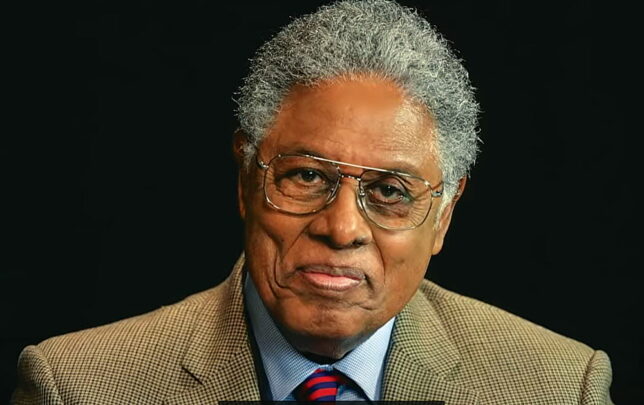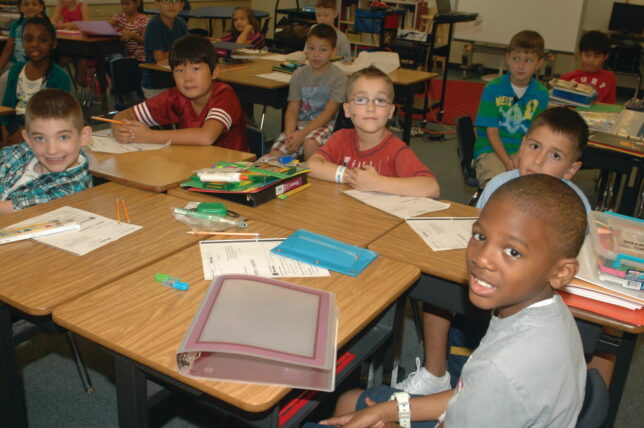Labor Watch
Teachers Unions and the Lowering of Standards: Black Education Success Stories
 Thomas Sowell concludes his thoughts. “What are the “secrets” of such successful schools? The biggest secret is that there are no secrets unless work is a secret. Work seems to be the only four-letter word that cannot be used in public today.” Credit: ReasonTV. License: https://bit.ly/42CYyrI.
Thomas Sowell concludes his thoughts. “What are the “secrets” of such successful schools? The biggest secret is that there are no secrets unless work is a secret. Work seems to be the only four-letter word that cannot be used in public today.” Credit: ReasonTV. License: https://bit.ly/42CYyrI.

Teachers Unions and the Lowering of Standards (full series)
Teaching in Compton | Behavior Standards
Academic Standards | Black Education Success Stories
Sowell Quotes Black Education Success Stories
The opposite view from that of the teachers unions is that these students need structure, discipline, and order. Especially minority students, who are unfortunately more likely to come from homes without a father figure to serve as a disciplinarian, need these firm boundaries and lofty expectations.
But again, the theory isn’t as critical as the results regarding our children’s welfare. It better work. So what does history tell us about which approach works best? We’ve seen the negative results of the misguided attempt by teachers unions to lower the behavioral and academic standards of our children. Let’s look at examples of success in education using high standards.
Thomas Sowell details several examples of excellence in black education in his book Black Rednecks and White Liberals. For instance, Dunbar High School in Washington, DC:
In 1899, there were four academic, public high schools in Washington, D.C.—one black and three white. In standardized tests given that year, students in the black high school averaged higher test scores than students in two of the three white high schools. Today, more than a century later, it would be considered Utopian even to set that as a goal, much less expect it to actually happen. Yet what happened back in 1899 was no isolated fluke. That same school repeatedly equaled or exceeded national norms on standardized tests in the 1930s, 1940s, and early 1950s.
So black children can pass standardized tests at high rates, even surpass white students, if the standards are high and the methods are effective. Sowell goes on to show that behavioral standards, unsurprisingly, were also increased at the Dunbar school, with “less absenteeism and less tardiness than the white high schools”—a tell-tale sign of general student conduct. Dunbar’s success was primarily due to teachers and administrators who did not give their students a “sense of victimhood or of doors closed.” Instead, strict, high-achieving role models in education, like Dunbar principal Mary Jane Patterson, who was known for her “strong, forceful personality” and was an “indefatigable worker,” led students to a high calling, and they met the mark. Nor did Dunbar focus extensively on black cultural issues, which today’s educational progressives claim is a necessary ingredient for minority students to even dream of succeeding in school. Nor did she focus on the very real injustices of the early 1900s, which far surpass the hardships any American racial groups face today. It seems high standards, devoid of pandering, were enough.
Many other historical and contemporary examples can be given. Sowell’s chapter “Black Education—Achievements, Myths and Tragedies” is full of them. Often the stories are very similar: The school has a majority of black or Hispanic students from disadvantaged economic backgrounds. The test scores and literacy rates are low, behavioral issues high, and then a new principal or teacher comes in and raises the bar. The children rise to the occasion, and academic scores rise while behavioral issues drop. It’s not very complicated.
Sowell reminds us of the film Stand and Deliver, based on the true story of math teacher Jaime Escalante, who was so successful in his no-nonsense/high-expectations approach to Calculus that “about one-fourth of all Mexican American students—in the entire country—passed Advanced Placement Calculus” came from his high school program. A less-known example is “the principal of Bennett-Kew Elementary School in Inglewood, California, with a student body that was 52 percent Hispanic and 45 percent black. He raised these children’s reading levels from the 3rd percentile to the 50th percentile in just four years.”
We could go on and on. Yet there is no specific, exact formula for achieving excellence in educating minority children, any more than having high academic and behavioral standards. Indeed, raising behavioral standards is a predictor of higher academic scores, the two factors being inseparable because of the truism that a child cannot learn in a disorderly and chaotic environment. Cascade Elementary school in Atlanta achieved reading and math scores at rates many would say are miraculous for a student body consisting of 99 percent black students, with 80 percent coming from low-income families. Yet their students scored “74th percentile on reading tests and at the 83rd percentile on math tests.” How did they do this? Getting rid of suspensions in the name of social justice? Far from it. To show how strictly this school was run, the principal, Alfonso L. Jesse, “explains to parents at the beginning of the year that if their children misbehave in school, they will be personally escorted to the parents’ place of work. Not surprisingly, Cascade has almost no discipline problems.”
My own experience tells the same story. Back when I was teaching at Kennedy Elementary in Compton, CA, around 60 percent of the students were Hispanic, 39 percent were black, and 1 percent were other. Now the school has 86 percent Hispanic students and 10 percent black. These are precisely the students the Left always touts as “underserved” or “marginalized.” Currently, 96 percent of the students at Kennedy Elementary come from low-income families. Their academic performance suffered when I was a teacher at the school 15 years ago, and they are still struggling today. Only 30 percent of the students are proficient in math, and proficiency in reading is not much better than 35 percent. If there was ever an argument for lowering the standards for minority or marginalized students to succeed, Kennedy Elementary could be the poster child.
Yet I saw a dramatic turnaround in my students in the short time I was there. When I arrived, I had to deal with cursing problems from elementary students so young it would shock many to hear them speak. I instituted strict discipline standards and created a system of rewards and punishments they could understand. To the surprise of no one blinded by leftist ideology, they rose to the occasion.
I’ll share an anecdote of how well they had bought into my system, told to me by my principal while I was at Kennedy Elementary. She was speaking with one of my students, a 4th grader, who interrupted the principal to let her know that she had to go because she couldn’t be late for Mrs. Fontanilla’s class. This wasn’t just out of duty or fear; she was excited to rush to my class. The kids craved the order. They cried when I left. This is what the teachers unions are denying our children.
Sowell concludes his thoughts better than I can. “What are the ‘secrets’ of such successful schools? The biggest secret is that there are no secrets unless work is a secret. Work seems to be the only four-letter word that cannot be used in public today.”

There is no specific, exact formula for achieving excellence in educating minority children, any more than having high academic and behavioral standards. Credit: Victoria Choi. License: https://bit.ly/42vEckt.
Closing Thoughts
What is behind the push to lower academic standards for our nation’s youth, especially urban minorities? And what about behavioral standards? Clearly, the new and more lenient approach to behavior in schools is not working. So why has it not been abandoned?
One could ask similar questions about the wave of retail store thefts in our nation’s largest cities, which so frequently litter our social media feeds with videos of smash-and-grab robberies. Why has this wave of crime not led to a reversal of the soft-on-crime reforms? Indeed, you could argue that one position, lack of discipline in schools, leads to the other, the decriminalization of theft and the resulting crime wave. Is it just a dogmatic clinging to woke ideology, no matter the cost? Or is it a deliberate attempt to destroy the lives of urban minorities? The motives may vary depending on the actor in this cast of characters, ranging from the true-believing social justice activist teacher in the classroom to the cynical blue state politician setting school policies. But again, the results, whatever the motive, remain the same for our children.
It’s beyond the scope of this article to give a complete account of motives but suffice it to say that powerful groups benefit when the people are illiterate, miseducated, and generally dependent on the government rather than independent. Outside forces must control a population that lacks self-control. They will even ask for it. We do not need to establish the existence of some nefarious conspiracy to show that there is a dire confluence of agendas and circumstances that result in the lowering of behavioral and academic standards of the next generation. Agenda or not, the results are the same. And our children pay the price.
This article was first published in the March/April 2023 issue of Capital Research magazine.



